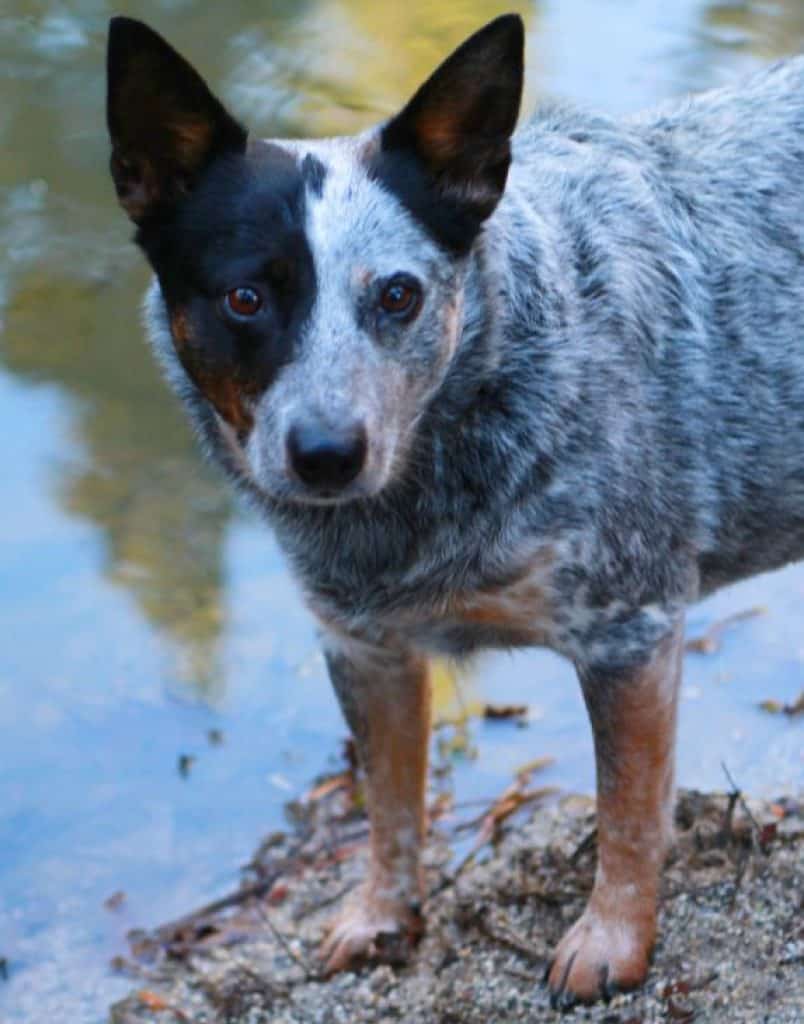Considering how you are a dog lover; you are always on the run to bring out the best in your Australian Cattle dog.
In general, 10 minutes of swimming is equivalent to 40-60 minutes of walking that you do with your furry friend every day.
This means you can feel free to take your Blue Heeler to all the thrilling outdoor activities like RVing and camping, hiking, kayaking, and swimming for that ever-needed fun..
It’s no secret that Blue Heeler likes water; here’s an in-depth guide to everything you need to know to indulge your dog in the water and how you can ensure his safety at all times.
[wpsm_toplist]
Do Blue Heelers (Australian Cattle Dogs) Like Water?

Yes, almost all Blue Heelers love the water, and they can’t wait to run and play in it.
Thus, unless the water is in the form of a bath, you are likely to find Blue Heelers jumping, swimming, and playing in the water to challenge their comfort zone and use their energy in the most productive way possible.
However, one thing to bear in mind is that as Blue Heelers all come with their own individual personalities, some may not be as much in love with water as others.
Here, forcing them can do more harm than good. These problems usually roost with their confidence issues rather than natural inability.
Can Blue Heelers (Australian Cattle Dogs) Swim?
One thing that is true for sure is that your Blue Heelers absolutely hate sitting idle all day.
Australian Cattle dogs are little balls of energy who love moving around and finding anything that can drain their energy.
That’s when swimming comes into the picture. It can be an excellent way to try them out and sleep like a baby.
Like most dogs, teaching an Blue Heeler to swim is not really necessary. Australian Cattle Dogs (ACD) is a breed that naturally loves the water, and they love to swim.
So if you find a Cattle Dog that cannot swim, it is usually more of a confidence issue than a natural inability.
Unlike most dogs, you usually don’t need to teach your furry friend how to swim. They are actually equipped with the doggy paddle that is enough for a swimming pool.
However, before you go to something challenging or deep, make sure your dog is perfectly comfortable with water.
Then, to help them further in this journey, you can stand beside them and give a cheer of encouragement to help motivate them to move further.
How To Teach Your Blue Heeler To Swim?

As mentioned earlier, most of the time, you wouldn’t need to teach your dog swimming as they naturally have the ability to use their instincts and start paddling right away.
However, it is essential to bear in mind that you also need to go slowly and gradually build your confidence for more advanced activities just like any other training.
If your dog is hesitant to swim, there are a few things you can do to help them build their confidence.
Start by putting on [amazon link=”B0081XIK4Q” title=”a lifejacket” link_icon=”amazon” /] to give them more support. These jackets are usually equipped with handles to help you control how far your dog goes.
Once you are confident enough to let the dog be on his own, you can attach a rope to that handle and pull him every time he’s moving too far away from you.
This will also allow him to understand his boundaries and figure out what is dangerous for him.
It’s okay to let your dog go and find his space, the more freedom he will have, the more confidence he will gain to expand his horizons and explore the sea.
However, if your dog is overwhelmed by the water or is panicking, give him rest and immediately get out of the water.
Alternatively, you can make swimming a lot easier for them by incorporating toys and balls in the swimming pool.
Swimming Safety Tips For Dogs
If your dog has recently gotten into swimming, I’m sure their safety is your biggest concern.
And why wouldn’t it be?
It’s all completely new, after all. So here are some of the potential risks that your dog has underwater and ways to prevent them.
Fatigue
Even if your dog has been swimming for years, long periods of staying in water can make them fatigued.
If you see your dog losing energy, remove them from the water and let them recover.
If you see their rear-going below the water, take them out of the water as they won’t correct themselves after that.
Chlorine
Chemicals like chlorine can irritate your dog’s skin and eyes, which can build up to be a bigger problem in the future.
If you notice your dog acting up because of that, immediately get him out of the pool and rinse his face with fresh water.
If you still see his eyes irritated, avoid the swimming pool for a few weeks and consult a vet.
Obstacles In The Lake
Always keep an eye on the obstacles in the lake or pond, which can pose a risk to your dog.
These objects can get caught in his fur and make it difficult to swim.
It is also recommended to remove your dog’s collar before swimming to ensure there aren’t any external weights dragging him down in the water.
Water In Ear
Water in the ear is a common problem that many ACDs face.
The worst thing you can do here is to ignore the side effects and go on with the day.
The chemicals or germs in the water can lead to numerous ear infections that can be difficult to tackle in the future.
If you see your dog struggling to get the water out of his ears, title and shake the dog until most of the water is removed.
You can then move on with a cloth to wipe out the rest of the water.
Swallowing Water
Swallowing too much water can lead to water intoxication; this is where the sodium levels outside the body cells become depleted. This state is called hyponatremia.
Here, the cells get swollen with fluid and cause intracranial pressure in your brain.
As a result, you can permanently damage your dog’s brain.
Therefore, always try to make sure your dog is ready for swimming before leaving him to be on his own.
And in case he does end up swallowing water, take him to the wet.
Benefits Of Swimming For Dogs
Sure, swimming can be fun, but there are many more benefits for your dog that can help him thrive in the healthiest way possible.
Exercise
The resistance of water is a lot more impactful than a workout on the land.
This will make it an excellent way to improve muscular strength and work up your cardiovascular and respiratory systems without spending hours on a walk.
In addition, this can be a great way to use up your dog’s energy and let him come back tired and ready to head straight to the bed.
Treat Physical Problems
Swimming has proven to fix many physical problems like hip and elbow dysplasia, stroke, paralysis, cruciate ligament tears, and arthritis.
Swimming can also play a big role, and getting an overnight dog sufficient exercise to land without putting much stress on his pints and bones.
Other than that, if your dog is suffering from maneuverability, then these can also be cured as swimming is excellent for all-body conditions and improves range of motion, all while being kind to your dog’s bones.
Recover From Injuries
Sustaining your dog’s bone density through swimming will not just prevent him from potential injuries but can help him recover from the past ones as well.
To make it an effective practice, make sure you are gradually building up the intensity and not being too harsh on his body.
It’s completely alright if your dog is active for the first few minutes of swimming; as his endurance increases, you can expect him to last a lot longer in water.
Burn Off Extra Energy
Many owners fail to realize that as your fur buddy is packed with energy, if not used in the right way, they can actually leash it out in the form of aggression or create a mess at home.
Through swimming, you can keep his behavior problems in check, and they use up this energy for something beneficial for them.
Conclusion
All in all, Australian Cattle Dogs (Blue Heelers) are fascinating dog breeds to begin with, and their ability to enjoy swimming is one of them.
Unlike many other dogs, they are great at using their energy productively and jump into the water to get their spirits high.
The best part is, you certainly don’t have to break your sweat and teach them swimming.
However, for those who lack the confidence to swim, you can easily get them to enjoy swimming as you like them with you to the beach or swimming pools.
Once they eliminate that fear, watch how your dog plays in the water and become your partner in all outdoor activities!





